Introduction
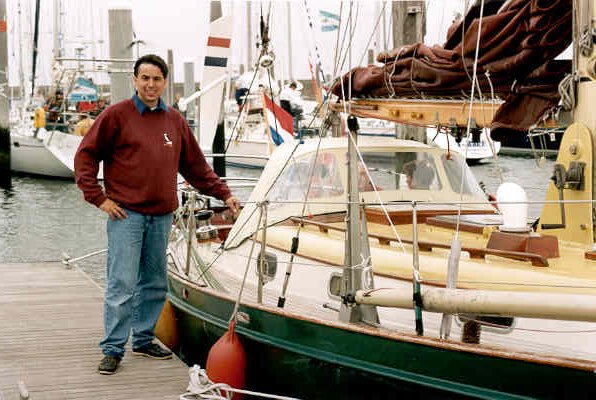

Hello and thank you for showing interest in my web site. Let me first introduce myself.
This is me (left picture) and our lovely Senta a few hours before the start of the 1200 nm. duo-handed Atlantic race IJmuiden - Lagos. On the right side my wife Monique with our children Henny jr. and Annemarie. Here we are sailing somewhere in the Aegean Sea in summer 1997. While I had a beautiful classic and very seaworthy monohull, with which we have made many beautiful and long distance sailing trips, at that time my interest in multihulls began to grow into desires that no longer could be ignored.
20 years later and with a bouquet of flowers in my hand, I find myself back on the dock behind our new house, just after the successful launch of my new self-built trimaran. On the picture below, my son sails the new boat to her home port where the christening ceremony is performed by my wife and daughter.

Now retired but professionally I was a structural engineer and Business Unit Director of a construction company in The Netherlands.

Homeport
We live in The Netherlands and for almost 55 years the city of Hilversum has been our hometown. Hilversum, nestled in the woods and moors of ″Het Gooi″, is the home of the Dutch radio and television industry, so that's why Hilversum is also called ″the Hollywood of the Netherlands″ (or Hillywood when reading too much scandal magazines). Despite the plentiful open spaces, it would be hard to swing a cat without hitting some minor celebrity or other. But if you did, at least they would get their name mentioned in the next edition of the newspapers.

At the beginning of 2010 we moved to the city of Lelystad where we found our ″dreamhouse″ with a private dock at the south side of the IJsselmeer lake, perfectly suited for our new trimaran.
Our new homeport Lelystad is founded in 1966, a new city in New Land (former Zuiderzee), a 30 miles away from Hilversum as well as Amsterdam, is now considered a green, wetland recreation area with the tranquility and space that the Amsterdam conurbation lacks. Yet Lelystad is also a paragon of modern architecture and urban planning. Many famous architects have contributed to that image.

The locks with connecting dike in the left uppercorner of the picture at right are the connection between the southern lake Markermeer and the northern lake IJsselmeer. Before the construction of the ″Afsluitdijk″ (Enclosure Dam) in 1932 these two lakes formed together the ″Zuiderzee″, a salt water inlet of the North Sea.
Through the construction of lifelike replicas, in Lelystad history is brought back to life again. Batavia shipyard enjoys a worldwide reputation for the original reconstruction of the VOC ship Batavia, yet the current construction programme involves De 7 Provinces: a new ship of Michiel de Ruyter, the 17th century Dutch naval hero.
However, in addition to historic shipbuilding, there are also some high tech shipyards active in Lelystad, responsible for some volvo ocean racing yachts and fast foiling multihulls.
South of Lelystad are the Oostvaardersplassen Lakes. In spite of the fact this is new land it looks like the Netherlands as it was thousands of years ago. It is an untouched swamp area with vast expanses of water and wild grasslands. Nature is still left to run its natural course here. It is a unique spot in the Netherlands and Europe.

Boat fever
I suffer from boat fever, a serious but costly disease, which originated somewhere early in my childhood and since then has only gotten worse.
I have learned sailing with the girl next door. She had a little dinghy and we learned each other how to sail and how to do all other things that teenager boys and girls are dreaming of. This Flits had a centerboard case which divided the cockpit floor in two parts. Besides it was the first time, making love on that narrow floor wasn't very satisfying.
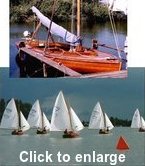 A 16m² (typical Dutch open sailing boat, also called BM after the builder Mr. Bulthuis and his Bulthuis Building Method) became the next ultimate dream. This boat had a fixed keel and therefore a great open cockpit floor without any obstructions. Perfect suitable for my planned holidays. The cockpit could be sheltered with a ″boom-tent″ and the floor is wide enough to sleep with two.
A 16m² (typical Dutch open sailing boat, also called BM after the builder Mr. Bulthuis and his Bulthuis Building Method) became the next ultimate dream. This boat had a fixed keel and therefore a great open cockpit floor without any obstructions. Perfect suitable for my planned holidays. The cockpit could be sheltered with a ″boom-tent″ and the floor is wide enough to sleep with two.
Unfortunately the girl next door preferred another boyfriend, but the biggest problem was money, to be exact the lack of it. And then, for a teenager boy there are more things to do then sailing alone.
The little money I earned with lots of small jobs disappeared in the fuel tank of first the motorcycle and later the old beetle car. At high school I choose friends who had parents with boats, I built a GRP kayak and another 16 of them for the business, and keep close to the water as often I could be.
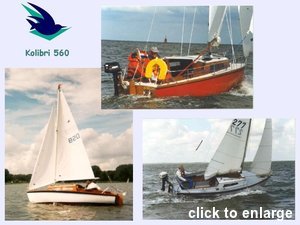
My 12 year older brother, who had often taken me on sailing trips with a rented 16m², build his own 18 ft. Kolibri (Hummingbird) sailing yacht in his garage. This boat was the real beginning of my boating fever. My brothers family became always seasick and strictly speaking he was more interested in aircrafts. Flying was his first love and the nice yellow painted Kolibri was called "SECOND LOVE" (and what about his wife?).
When he obtained his pilot's licence his love for the yellow bird was definitely over, in spite of her name. This was my chance! In exchange for maintaining and repainting the yacht I could use it for a year. I went offshore with this little yacht and almost drowned in heavy weather. That was quite a treat. It was real and it was what I wanted.

The day after I got my first real and paid job, I went to the bank for a loan. After a quick search on the second hand boat market I realised that the only way I could get a suitable boat without losing my money was building her by myself.
Just like my brother with the Kolibri I bought a kit version of a 24 ft. wooden Waarschip (named after her birthplace, the small village 't Waar in the very North of the Netherlands). This boat was advertised in 1980 as made of synthetic wood. It was build in marine ply and preserved with West system. I named her PIONIER and have sailed this incredible yacht for 12 years, mostly offshore to foreign countries, and sold her for almost double the money I spend on building and equipment (not counting all the labour).
She became too small, or better said, every next year the horizon was further away. 24 ft. isn't very much offshore and sometimes it is very inconvenient. The new owner is sailing her on a inner lake, preparing himself for the blue water. PIONIER won't disappoint him.
I thought of building a 34ft. Van de Stadt sloop or even a Woods catamaran and bought both study plans. By then my preconceived opinion about multihulls was rapidly changing. On one of our sailing trips we met a family with a home built 38 ft. catamaran named THE FLYING DUTCHMAN (what's in a name) without the caravan on top and only small accommodation in the two hulls. For the first time in my live I saw (and realized) the benefits of a multihull. I discovered even more catamarans that won't contribute to reducing my boat fever, such as the Edelcat 35 or the Louisiane.
Back to earth our first child was born and the home-building-boat-plans were parked in the freezer. I rebuild our house with an extension to the living room as well as to the garage, also with a hidden motive in mind of building a new boat here in the future. Until then the new created space was used as storage, workshop and place to refit PIONIER.
As always I studied the second hand boat market in the magazines and newspapers. In order to have some reading material during a sailing trip to the Shetland Islands, I bought the extra-thick Saturday edition from the local newspaper, and there she was, SENTA, a beautiful and famous old lady. A lot of water all over the world had passed her long keel since her building by the Royal Huisman shipyard in 1970, a yard nowadays only reserved for the happy few on eart.
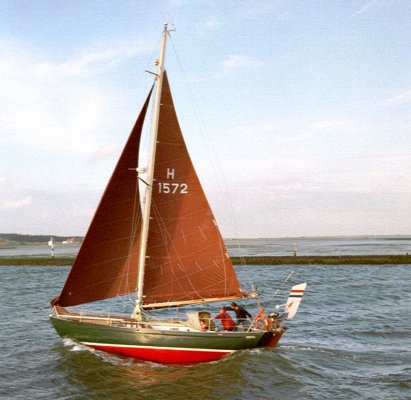 She is a one-off design by D. Koopmans Sr. and special made for a single-handed circum navigation by her original owner, Dr. Cees den Hartoog. I knew that boat from her stories in the sailing magazins. I could hardly wait to get back from that sailing trip to honor the selling broker with a visit.
She is a one-off design by D. Koopmans Sr. and special made for a single-handed circum navigation by her original owner, Dr. Cees den Hartoog. I knew that boat from her stories in the sailing magazins. I could hardly wait to get back from that sailing trip to honor the selling broker with a visit.
It was love at first sight. A beautiful 36ft. S-shaped aluminium hull, made for the ocean. This was the yacht that could bring us everywhere we want ...... and she did ....... and how!
We sailed her to the North and to the South. With the exception of Finland and Polen we have visit all the sea-located countries of Europe and the North of Africa. We won prices. She never disappointed us and was safe in extreme heavy weather. We had a wonderful time with her.
Once we were sailing in the Greek Aegean Sea with a very strong northerly, locally known as the Meltemi. It blew with 30 kn. and more. The sea was rough with steep breaking waves. In front of us there was a yacht with a strange behavior. Sailing wasn't easy and I thought for a while the yacht had problems and needed help. Still the yacht was far away and with my binoculars I could point out it was a catamaran. Strange enough it didn't come any closer but sailed on the same course as we did. It took almost the whole afternoon before I could catch her up. And then there was nothing wrong with her. In these strong winds and large waves it was probably her normal behavior, like a raft. The crew waved at us when we passed ....
Ok Ok, it was probably a bare boat charter, but I was happy to be on my own steady SENTA, dragging her gunwale through the water and going faster than the cat. It contributed to my prejudice with catamarans in mind. Hmm...
On another occasion we were in the overcrowded harbor of Isle de la Croix in the north of Biscay. We came in as one of the last boats who could enter the harbor. The small inner harbor was completely stuffed with yachts, who were tied up between some big rusty moorings. No free place left and the boats on the outside (like us) had almost nothing to hang onto. Then there was that at least 40 ft. French Cat. She came in and muddled along the yachts, came very close behind our stern and searched her way to the very inner side of the harbor. What is she looking for? There is no place anymore or ...... she anchored in no more than two feet of water with more than enough surrounding room.
Oh boy, it's really true, a multihull doesn't need more water to float. Ever since in every harbor I am looking for that kind of spots not suitable for keelboats but kind enough for a multihull. And almost every harbor (except marina's, but I don't like them anyway) have such spots.

Trimaran
I can not remember anymore that I began to consider a trimaran as a serious option for the multihull I had in mind. Untill then, the trimaran was still some kind of strange exotic, fast but ugly floating beast. I've met the Formule 40 racers in France as if they were coming from another planet.
Through a tip from a colleague I got to know the folding F-boat trimarans, strange folded birds that could be trailered behind the car. To me they looked as day-sailors with hardly any accommodation inside.
Then there was our annual Hiswa Boat Show in Amsterdam. On the other side of the exhibition there was a strange ugly bird that caught my eye. Parked along the jetty she was a halfway build and unpainted trimaran with one folded float (the other wasn't ready yet).
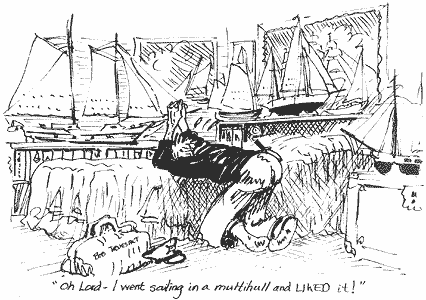 Started as a home-build project the reason for showing was to check the interest for this TRIMAX design and the possibilities for a production version. (TRI with MAX speed and accommodation)
Started as a home-build project the reason for showing was to check the interest for this TRIMAX design and the possibilities for a production version. (TRI with MAX speed and accommodation)
Looking with screwed up eyes I saw the beauty of her body. With 35 ft. in length and a suitable accommodation this great design from Dutch designer Peter Bosgraaf was worth a further investigation. It gave me a new insight in trimaran concepts.
I went sailing in the prototype of the Trimax trimaran and was hooked ....
Nevertheless there were a lot of things that had to be improved, of course attributable to the prototype nature of the boat. For first buyers there was an extra discount, but the costs were above my budget. Also the lack of experience and the strong impression I was going to support an experiment didn't seem right to me. The folding system looked to be a copy of the Farrier Folding system.
″There are three desirable qualities in a boat: speed, accommodations, and low cost, - choose any two″ again is a very true dictum !
This was however the first important step in choosing the boat that was to become ″my dreamboat″. After a lifetime in mono-hulls, the choice of a trimaran was made. Her very fast sailing capabilities as well as the shallow draught were promises of a new way of sailing.
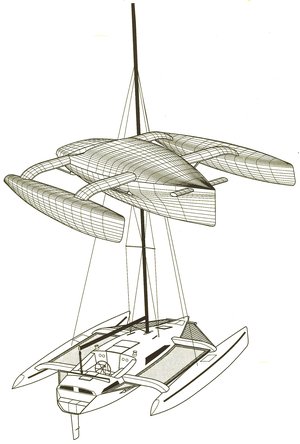
At the same time I discovered the Internet, still through a dial-in modem. Barefaced I lurked all over the Net searching for multihulls and particularly trimarans. I discovered the F-boats again and to my surprise there was also a bigger version available, the F-36. Now this was all I needed. No experiment, but a decent design with the highest references and everything on the right place. The accommodation seems to be even more spacious than on my 36 ft. SENTA.
After purchasing the study plans and after a thoroughly examination of Farrier's website the decision was easily made. The determining factor was the superbly detailed building plans and the building method. The more I studied the plans, the more I realized that this boat is an engineering marvel and accompanied by an building method that I could manage. So all necessary attributes for an high quality yacht!
However, in that time most of my sailing friends were thinking I was becoming crazy. In Monohull land Multihull is almost a dirty word. I even heard about Monohull ego's considering Multihullers in general to be rather a low form of animal life.

When I explained my plans to one of my sailing friends, he replied:
A multihull, that's a kind of thing with two hulls and a caravan on top. Plenty of room OK, but very ugly also. It can't be seaworthy. Those things are dangerous, they flip. Don't you know about the risk of capsize of this type of vessel. You can't do this to your wife and kids. Much to dangerous. You don't want such a boat. Look at your lovely SENTA. That is a real boat.
Indeed, but I didn't mention a so called catamaran. I am going to build a trimaran. My friend eyes became even bigger.
A trimaran! he said. That's a catamaran with three hulls? Yeah, a boat with training-wheels, you can't be serious !
I am exaggerating though, but monoslug sailors like to speak that way about multihulls. Yes indeed, as a novice multihuller I also learnt some new words, like monoslug, leaner, sinker, leadslinger and leadmine.
I didn't make myself popular by telling the next story:
As we all know the first man who crossed the ocean was not Columbus, or the Vikings, or Brendan, but the Polynesians in their multihulls. These guys were sailing proas across vast distances while the ″civilised″ countries of the world were still trying to find the end of the English Channel. They understood the ocean and the forces involved with. Instead of viewing the sea as an enemy to be fought against with heavy ships, the Polynesians looked on the sea with respect and skimmed over her surface in light craft. Centuries before our forefathers invented the dugout canoe, the Polynesians were migrating through the Pacific with their pahi's and proa's. With their ″crab claw″ sail they were much more capable of sailing to windward then their discoverers 2000 years later in their heavy ballasted square rigged barques. Abel Tasman and Captain Cook were very surprised by the easy and fast moving of these Polynesian outriggers.
Lucky enough, as in modern times, the conservative sailing bunch showed little interest in such a crude native contraption. Nathanael Herreshof knew better and with his 25 ft. catamaran design he beat the entire fleet of the New York Yacht Club with ease. Here he touched a sensitive spot of the conservative establishment and they treated his catamaran as unsporting and unwanted. He returned to the monohulls and went on to become famous for his America's Cup designs. It wasn't the time yet, but for sure he was right !!
One of the most important secrets of the multihull is light weight. Why should you carry tons and tons of ballast in the keel with you?
To keep her up and running? Quite a primitive solution, you have to carry this all the way long and don't estimate the risk of sinking with al that weight! Read the newspapers about these catastrophes!
By the way, there are only three types of sailboats anyway. As I explained before, the Polynesians have the rights on the real ″boat″, the catamaran or proa. Then there is a ″boat and a half″, the trimaran (that's why this type of vessel is more costly), and finally we can all feel sorry for those who sail ″half boats″, the monomaran or monohull.
I can't wait for the day I am sailing along pretty level and sure very fast and watching your ″half-boats″ with their rails in the water.
All kidding aside, the ideal boat probably doesn't exist, except in dreams. These dreams depend of our experiences and priorities in sailing. And these can be different through the years.
First I wanted to go sailing. It doesn't matter in what kind of boat as long as it was floating. Then I wanted to travel to foreign coasts. Year after year and with the increase of experience still further away. Then the challenge of long distance racing. And then ..... I wanted to sail faster ..... on a boat I can handle on my own without a bunch of gorilla's for winches and sail.
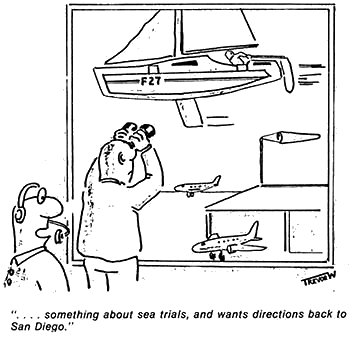
Of course this is an over-simplification, but the enjoyment of sailing is in direct proportion to speed. Fast = fun, faster = more fun. This also applies to the cruising sailor or traditionalist. Think about it, it is true!
So I am bored sailing from A to B with an average of 5 to 6 kn. This sounds perhaps a little overdone, but I am ready for a new challenge. It has to do with the evolution in my (and my family) sailing experiences.
My fever has risen to unprecedented levels and can only fall by a radical action, starting a new building adventure with the build of my F-boat trimaran.
Five years after the actual start of the construction of Fram, I think it was 2008, I've sold my so beloved SENTA. It went to my heart but SENTA has been sold to a lucky new owner, who will continue her adventures.
But knowing that we were in the middle of a new adventure, hopefully with a very high tech and lightweight high performance sailing craft and even future horizons still further away, makes it a good feeling to let her go to the next dedicated owner.

Epilogue
So, why not a catamaran ?
A catamaran has great benefits: she heels less, is cheaper and quicker to build, has more deck area, is less exotic and better excepted by the sailing crowd (and insurance companies!), she is a better load carrier, with twin engines easy maneuverable, has more accommodation and the two separate hulls give more privacy, less overall beam and finally one less hull to scrub and paint !
Well, my simple answer is: a trimaran is more boat (one and a half to be exactly), offers overall the best all round performance and still has the thrill of fast sailing, steers like a dinghy, the more positive tacking motion and in the groove feeling while going to windward.
It's motion, tack ability, handling, abscense of bridgedeck slamming, construction and support for mast and stays is all better matching with my monohull roots! In fact, as a friend of mine said, ″it's a monohull with side-wheels″. The tri combines the speed of a (fast) cat with the maneuverability under sail of a monohull.

There is still one problem I have to find out in practice. Twice in my live my boat had to take care for me and for herself. With the hatches closed watertight and everything tight up there wasn't more to do then waiting inside for things to calm down. Outside was only salt water and little air.
Heavy weather tactic with a trimaran is different. She requires more action and care. Where the monohull may have some forgiveness, the trimaran does not. If flipped, she stays flipped. This doesn't mean the trimaran is unsafe to operate in severe conditions or that the monohull isn't susceptible to suffering the ultimate hazard of sinking. In the end, the ultimate hazard of the multihull (capsize) is less severe than the ultimate hazard of the monohull (sinking). After all, the trimaran's ultimate stability position is floating upside down, where it makes a great liferaft. The monohull's ultimate stability position is resting on the bottom where it makes a good fish farm. (quote Ian Farrier)
The F-Boat is unsinkable from many separate watertight compartments, the material she is made from and no heavy ballast. There's a reassuring sense of security in knowing that no matter what, the tri cannot sink. (7.000 containers are yearly lost by freighters !)
On the other hand, the trimaran's speed abilities makes it possible to steer her clear of the worst. The high performance capability means one can frequently outrun bad weather to be snug and safe in harbor while slower craft have to remain at sea.
With a boat that has a top speed of 25 knots and can maintain averages of over 15 knots, limiting top speed to say 15 knots, or averages to around 10 knots, gives a responsible and very safe margin for secure general family sailing.
At right a foretaste of sailing with a
trimaran aboard Gary Mulder's F36.
Most life threatening risks (besides of driving your car!) are :
1. falling overboard;
2. fire;
3. being run over;

and this is independent of being mono, cat or tri !
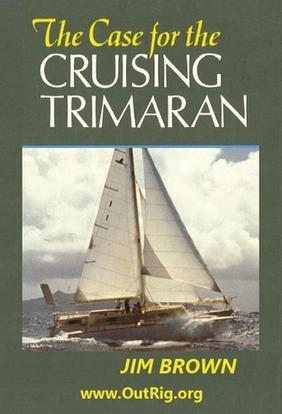
The Case for the Cruising Trimaran
By the way, a good book to read is ″The Case for the Cruising Trimaran″ by Jim Brown.
This classic book about cruising trimarans is now back in print! Well-known trimaran designer Jim Brown offers his unique experiences and insight into the design factors that make for safe, seaworthy, comfortable trimarans.
Jim is always entertaining in his writing, and this book is no exception. He blends personal stories with technical information about these fast vessels, and shows why multihull pioneers in the 20th century were sometimes referred to as the ″Hells Angels of the Sea″.
Much of the book is dedicated to the subject of ″capsizing,″ and offers timeless wisdom on how it can be prevented. There is even a chapter about ″self-rescue″, and a technique for how a capsized vessel can be righted.
This book is fully illustrated with original black and white photos and humorous illustrations by Jo Hudson. Multihullers in general (and trimaran lovers in particular) will discover Jim Brown's sailing philosophy and walk away with a thorough understanding of the features and benefits offered in well-designed and properly handled cruising trimarans.
| « Previous Next » |